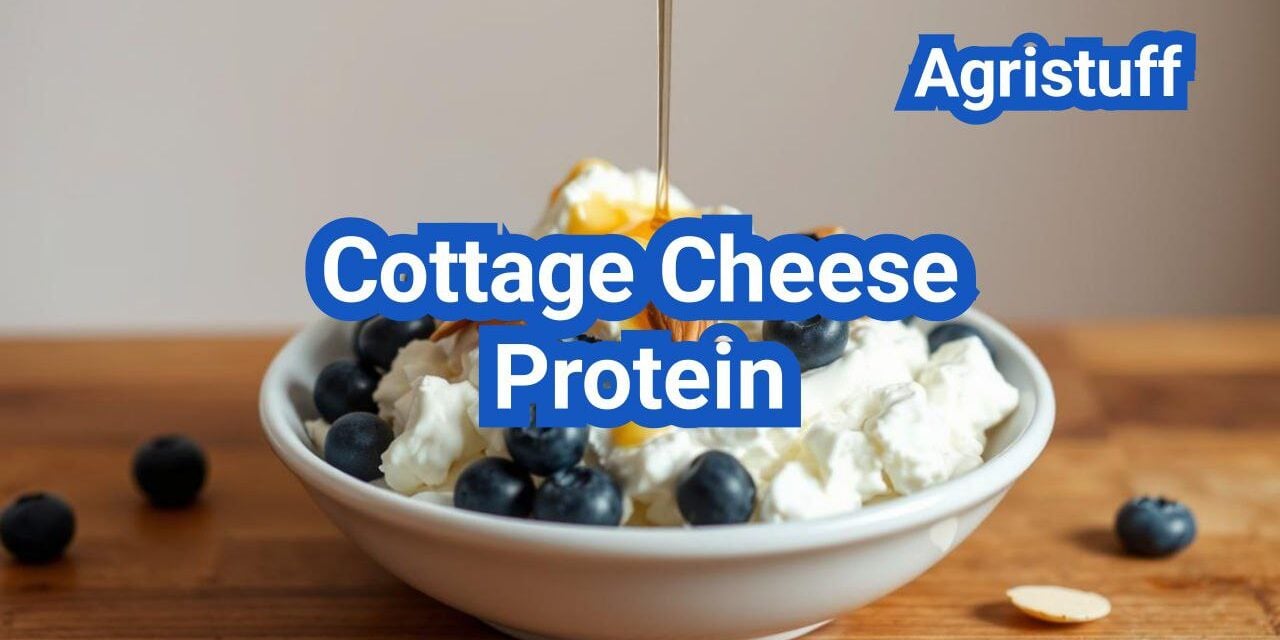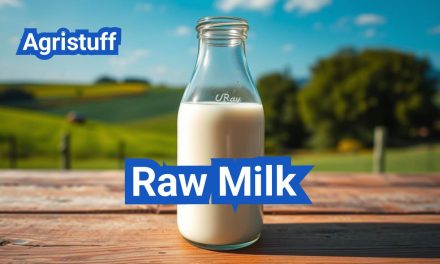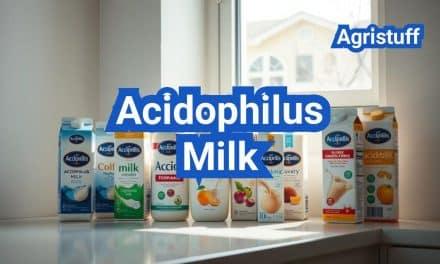This article does not contain medical advice
Boosting your protein intake can be simple with the right foods. Cottage cheese is an excellent source, offering about 12 grams of protein per 1/2 cup serving, according to the American Dairy Association.
With its high protein content, cottage cheese is a versatile ingredient for various recipes, making it easy to achieve your daily protein goals. Whether you’re looking for a high protein breakfast or a post-workout snack, cottage cheese can help.
Achieving 30g of protein isn’t complicated when you incorporate cottage cheese into your meals. This introduction will explore simple recipes to help you hit your protein targets.
Key Takeaways
- Understand the protein content in cottage cheese.
- Learn simple recipes to boost your protein intake.
- Discover how to achieve 30g of protein with cottage cheese.
- Explore versatile ways to include cottage cheese in your diet.
- Start your day with a high protein breakfast using cottage cheese.
The Power of Cottage Cheese Protein
With its rich nutritional profile, cottage cheese stands out as an excellent source of protein. Cottage cheese is particularly notable for its high casein protein content, which is beneficial for muscle growth and repair. This makes it an ideal dietary component for individuals looking to enhance their protein intake.
What Makes Cottage Cheese a Protein Powerhouse
Cottage cheese is considered a protein powerhouse due to its high protein content and complete amino acid profile. It contains casein protein, which is slowly digested, providing a sustained release of amino acids into the bloodstream. This characteristic makes cottage cheese particularly beneficial for muscle recovery and growth, especially when consumed before bedtime.
The benefits of cottage cheese protein extend beyond muscle repair. It also supports overall health by contributing to a feeling of fullness, which can be beneficial for weight management. Moreover, cottage cheese is rich in various micronutrients, including calcium, phosphorus, and potassium, which are essential for bone health and other bodily functions.
Why 30g of Protein Matters for Health
Consuming 30g of protein per meal is often recommended because it helps to maximize muscle protein synthesis, which is crucial for muscle growth and repair. This amount is particularly significant for individuals engaged in regular physical activity or those looking to maintain or increase muscle mass. The protein in cottage cheese can significantly contribute to achieving this daily protein goal.
Achieving 30g of protein per meal can be straightforward with cottage cheese, as just one cup can contain around 28g of protein. This makes it an efficient and convenient protein source, especially when compared to other dairy products like Greek yogurt.
How Cottage Cheese Fits into a Balanced Diet
Incorporating cottage cheese into a balanced diet is relatively simple due to its versatility. It can be consumed on its own, mixed with fruits or nuts, or used as an ingredient in various recipes. When comparing cottage cheese vs Greek yogurt protein, cottage cheese often has a higher protein content, making it a preferable choice for those seeking to maximize their protein intake.
Cottage cheese can be part of a healthy diet that supports overall well-being. Its nutrient-rich profile, combined with its high protein content, makes it an excellent addition to meals or snacks, contributing to a balanced and nutritious diet.
Nutritional Breakdown of Cottage Cheese

Cottage cheese stands out as a dairy product that is not only rich in protein but also packed with various essential nutrients. Its nutritional profile makes it a valuable addition to a healthy diet.
Protein Content per 100g
Cottage cheese is an excellent source of protein, with approximately 11-12 grams of protein per 100g. This high protein content is one of the reasons it is favored by fitness enthusiasts and individuals looking to increase their protein intake.
Protein Content per Cup
One cup of cottage cheese contains around 28 grams of protein, making it an ideal choice for those seeking to boost their protein consumption. This is particularly beneficial for muscle repair and growth.
Fat Content and Calorie Considerations
The fat content in cottage cheese can vary, with options ranging from non-fat to full-fat versions. Generally, a cup of cottage cheese can contain anywhere from 80 to 220 calories, depending on the fat content. Choosing lower-fat versions can help manage calorie intake while still benefiting from its high protein content.
Micronutrients in Cottage Cheese
Beyond its protein content, cottage cheese is also a good source of various micronutrients, including calcium, phosphorus, and B vitamins. These nutrients play crucial roles in bone health, energy production, and other bodily functions. Incorporating cottage cheese into one’s diet can thus contribute to overall nutritional well-being.
Understanding Cottage Cheese Protein Types
Casein protein, found abundantly in cottage cheese, offers unique benefits for muscle recovery. Cottage cheese is an excellent source of protein, particularly casein protein, which is known for its slow-digesting properties. This characteristic makes it beneficial for muscle recovery and growth, especially when consumed before bedtime or between meals.
Casein Protein: The Slow-Digesting Advantage
Casein protein is a type of protein that digests slowly, providing a sustained release of amino acids into the bloodstream. This slow digestion helps in maintaining a positive nitrogen balance, crucial for muscle growth and repair. The slow-digesting advantage of casein protein makes cottage cheese an ideal snack for individuals looking to support muscle recovery over an extended period.
Complete Amino Acid Profile
Cottage cheese contains a complete amino acid profile, meaning it provides all nine essential amino acids necessary for the body. These amino acids are vital for various bodily functions, including muscle synthesis and repair. A complete amino acid profile ensures that the body has the necessary building blocks to support muscle growth and recovery.
| Amino Acid | Amount per 100g Cottage Cheese |
|---|---|
| Histidine | 1.2g |
| Isoleucine | 1.8g |
| Leucine | 3.2g |
| Lysine | 2.7g |
| Methionine | 0.8g |
How Cottage Cheese Protein Supports Muscle Growth
Cottage cheese protein supports muscle growth by providing a sustained release of amino acids, thanks to its casein protein content. This sustained release helps in promoting muscle protein synthesis, a critical process for muscle growth and repair. Additionally, the complete amino acid profile in cottage cheese ensures that the muscles receive all the necessary nutrients for optimal growth.
By incorporating cottage cheese into their diet, individuals can support their muscle-building goals. The protein in cottage cheese, particularly casein, plays a significant role in muscle recovery and growth, making it a valuable addition to a fitness regimen.
Cottage Cheese vs. Other Protein Sources

Cottage cheese stands out among various protein sources, but how does it stack up against Greek yogurt and other alternatives? When evaluating protein sources, it’s essential to consider factors like protein content, nutritional value, and versatility in recipes.
Cottage Cheese vs. Greek Yogurt Protein Comparison
Cottage cheese and Greek yogurt are both popular dairy products known for their high protein content. However, cottage cheese generally has a higher protein content per serving compared to Greek yogurt. For instance, a cup of cottage cheese can contain around 28 grams of protein, while a cup of Greek yogurt typically contains about 20 grams.
Another significant difference lies in their texture and usage in recipes. Cottage cheese has a lumpier texture and is often used in savory dishes or as a topping, whereas Greek yogurt is smoother and commonly used in both sweet and savory recipes.
How Cottage Cheese Compares to Meat Proteins
When comparing cottage cheese to meat proteins like chicken, beef, or fish, the primary difference lies in their amino acid profiles and digestion rates. Meat proteins are considered complete proteins because they contain all nine essential amino acids necessary for muscle growth and repair. Cottage cheese, while not a complete protein on its own, can be part of a complete protein meal when paired with other foods.
Cottage cheese has a slower digestion rate compared to many meat proteins, providing a sustained release of amino acids into the bloodstream. This can be beneficial for muscle recovery over an extended period.
Cottage Cheese vs. Plant-Based Protein Options
Plant-based protein sources, such as beans, lentils, tofu, and tempeh, offer a viable alternative to dairy-based proteins like cottage cheese. While plant-based proteins can be lower in certain amino acids, combining different plant-based proteins can provide a complete amino acid profile. Cottage cheese, with its high protein content and rich nutrient profile, can be a valuable addition to a diet that includes plant-based proteins, enhancing overall protein intake.
In conclusion, cottage cheese offers a unique set of nutritional benefits and can be a valuable component of a balanced diet, whether you’re comparing it to Greek yogurt, meat proteins, or plant-based options.
Selecting the Best Cottage Cheese for Protein
With numerous cottage cheese brands available, identifying the one with the highest protein content is essential. When shopping for cottage cheese, it’s not just about picking any brand; it’s about choosing one that aligns with your protein goals.
Top Brands with Highest Protein Content
Several brands stand out for their high protein content. Here are a few:
- Graham’s Protein Cottage Cheese: Known for its high protein content, Graham’s is a popular choice among fitness enthusiasts.
- Other notable brands: Brands like Daisy and Good Culture are also recognized for their protein-rich cottage cheese options.
| Brand | Protein Content per Cup |
|---|---|
| Graham’s Protein Cottage Cheese | 28g |
| Daisy Cottage Cheese | 25g |
| Good Culture Cottage Cheese | 24g |
Graham’s Protein Cottage Cheese Review
Graham’s Protein Cottage Cheese is particularly noteworthy for its high protein content and minimal added sugars. It’s a great option for those looking to boost their protein intake without consuming excessive calories or additives.
Reading Labels: What to Look For
When selecting a cottage cheese, reading the label is crucial. Here are key factors to consider:
- Protein Content: Look for brands that clearly state the protein content per serving.
- Added Sugars: Opt for brands with minimal or no added sugars.
- Calcium Content: Cottage cheese is a good source of calcium; check the label to ensure it meets your needs.
By carefully reading labels and choosing brands with high protein content, you can make informed decisions that support your dietary goals.
Specialty Cottage Cheese Options for Dietary Needs

Specialty cottage cheese options are available for those with specific health or dietary needs. Consumers are increasingly looking for products that cater to their individual requirements, whether it’s reducing sodium intake, managing lactose intolerance, or choosing organic or grass-fed options.
Low Sodium Cottage Cheese Brands
For individuals on a low-sodium diet, there are several cottage cheese brands that offer reduced sodium options. Some popular brands include those that specifically label their products as “low sodium” or “reduced sodium.” When shopping, it’s essential to check the nutrition label to ensure the sodium content meets your dietary needs.
Lactose-Free Cottage Cheese Options
Lactose-free cottage cheese is an excellent alternative for those with lactose intolerance. Several brands now offer lactose-free versions by adding lactase, the enzyme that breaks down lactose. This makes it possible for individuals with lactose intolerance to enjoy the nutritional benefits of cottage cheese without discomfort.
Organic and Grass-Fed Varieties
For consumers who prioritize organic or grass-fed products, there are cottage cheese options available that meet these standards. Organic cottage cheese is made from the milk of cows raised on organic feed, without antibiotics or hormones. Grass-fed cottage cheese comes from cows that graze on grass, potentially offering a different fatty acid profile and higher levels of certain nutrients.
When selecting a specialty cottage cheese, it’s crucial to read labels carefully to ensure the product meets your specific dietary needs. Whether you’re looking for low sodium, lactose-free, or organic options, there’s a cottage cheese available to suit your requirements.
How to Create a 30g Protein Breakfast with Cottage Cheese

Achieving 30g of protein for breakfast is easier than you think with the help of cottage cheese. Cottage cheese is a versatile and nutritious ingredient that can be incorporated into various breakfast recipes to boost protein intake.
Simple Cottage Cheese Breakfast Bowl
A simple yet delicious way to start your day is with a cottage cheese breakfast bowl. Mix 1/2 cup of cottage cheese with your favorite fruits and nuts. This bowl provides approximately 10g of protein. To reach 30g, consider adding other protein sources like nuts, seeds, or protein powder.
For example, adding a scoop of your favorite protein powder and a handful of almonds can easily get you to 30g of protein.
Cottage Cheese Protein Pancakes
Cottage cheese protein pancakes are a tasty breakfast option that can pack a significant protein punch. By mixing cottage cheese with eggs and protein powder, you can create a batter that yields pancakes with around 15g of protein per serving.
To make: Blend 1/2 cup cottage cheese, 2 eggs, and 1 scoop protein powder. Cook on a non-stick pan like regular pancakes. Top with fruits or syrup for added flavor.
High Protein Cottage Cheese Smoothie
For those on-the-go, a high protein cottage cheese smoothie is an ideal breakfast solution. Blending cottage cheese with milk, fruits, and a scoop of protein powder can result in a smoothie with approximately 20g of protein.
To enhance it to 30g, consider adding other protein-rich ingredients like Greek yogurt or additional protein powder.
As “Cottage cheese is an excellent source of protein and can be easily incorporated into various breakfast recipes.” – A statement that highlights the versatility and nutritional value of cottage cheese.
By combining these recipes or adjusting portion sizes, achieving a 30g protein breakfast becomes straightforward. Whether you prefer a simple bowl, pancakes, or a smoothie, cottage cheese is a valuable ingredient in your high-protein breakfast arsenal.
Quick Lunch Ideas to Hit 30g Protein with Cottage Cheese

Boost your lunch with cottage cheese-based recipes that deliver 30g of protein. Cottage cheese is a versatile ingredient that can be incorporated into various dishes to enhance their protein content. Here are some quick and nutritious lunch ideas that use cottage cheese as a main component.
Savory Cottage Cheese Wraps
Cottage cheese makes an excellent filling for wraps, adding protein and creaminess. To make a savory cottage cheese wrap, mix 1/2 cup of cottage cheese with chopped herbs like parsley or dill, and a pinch of salt. Spread this mixture on a whole wheat tortilla, add sliced turkey or chicken, and roll up. This wrap provides approximately 25g of protein. Adding some spinach or avocado can further enhance the nutritional value.
Here’s a simple recipe to make a savory cottage cheese wrap:
- 1/2 cup cottage cheese
- 1 tablespoon chopped fresh herbs
- 1/4 teaspoon salt
- 1 whole wheat tortilla
- 2 slices of turkey or chicken breast
Protein-Packed Salad Toppers
Adding cottage cheese to salads is another great way to boost protein intake. Mix cottage cheese with diced veggies like cucumbers, bell peppers, or cherry tomatoes for added flavor and nutrition. A serving of 1/2 cup cottage cheese on top of a green salad can contribute around 28g of protein.
Try this protein-packed salad recipe:
| Ingredient | Quantity | Protein Content |
|---|---|---|
| Cottage Cheese | 1/2 cup | 28g |
| Mixed Greens | 2 cups | 2g |
| Cucumber | 1/2 cup sliced | 1g |
| Cherry Tomatoes | 1/2 cup halved | 1g |
| Total | 32g |
Cottage Cheese as a High-Protein Mayo Substitute
Cottage cheese can be blended into a creamy consistency, making it a great substitute for mayonnaise in sandwiches or salads. Using cottage cheese instead of mayo not only increases the protein content but also reduces the calorie and fat intake. A tablespoon of cottage cheese provides about 3g of protein.
By incorporating these ideas into your lunch routine, you can easily achieve your 30g protein goal. Whether it’s through savory wraps, protein-packed salads, or using cottage cheese as a mayo substitute, there are numerous ways to make cottage cheese a part of your high-protein diet.
Dinner Recipes Featuring Cottage Cheese Protein

Dinner recipes featuring cottage cheese as a main protein source offer a delicious way to meet daily protein needs. Cottage cheese can be incorporated into various dinner dishes, from stuffed proteins to creamy pasta sauces and hearty casseroles.
Cottage Cheese Stuffed Proteins
One creative way to use cottage cheese in dinner recipes is by stuffing it into proteins like chicken breasts. Mixing cottage cheese with herbs and spices, then filling chicken breasts with this mixture, creates a high-protein dish that’s both flavorful and nutritious. Cottage cheese stuffed chicken is a popular recipe that combines the protein-rich benefits of cottage cheese with the lean protein of chicken.
Creamy High-Protein Pasta Dishes
Cottage cheese can also be used to create creamy pasta sauces that are high in protein. By blending cottage cheese with garlic, olive oil, and herbs, you can make a delicious and healthy pasta sauce. Combining this sauce with whole-grain pasta and lean proteins like grilled chicken or turkey sausage results in a well-rounded, high-protein meal. These creamy pasta dishes are not only satisfying but also packed with nutrients.
Cottage Cheese Casseroles with 30g+ Protein
Casseroles are another excellent way to incorporate cottage cheese into dinner recipes. By mixing cottage cheese with other protein sources like ground turkey or beef, and adding vegetables and whole grains, you can create casseroles that offer 30 grams of protein or more per serving. These cottage cheese casseroles are perfect for meal prep and can be customized to suit various dietary preferences.
These dinner recipes showcase the versatility of cottage cheese as a protein source and demonstrate how it can be used to create a variety of high-protein meals. Whether you’re looking for a simple stuffed chicken recipe or a hearty casserole, cottage cheese can be a valuable addition to your dinner repertoire.
Cottage Cheese Protein Smoothies and Shakes

Blending cottage cheese into your smoothies is a game-changer for boosting protein intake. Cottage cheese adds a creamy texture and a significant amount of protein, making it an ideal ingredient for those looking to enhance their smoothies and shakes.
Basic 30g Protein Smoothie Formula
Creating a 30g protein smoothie with cottage cheese is straightforward. Start with a base of 1/2 cup cottage cheese, which provides about 28g of protein. Add your choice of fruits, such as berries or banana, for natural sweetness and extra nutrients. You can also include a scoop of your favorite protein powder to further boost the protein content if needed.
To make the smoothie more palatable, consider adding a splash of milk or a non-dairy alternative. Blend all the ingredients until smooth, and adjust the consistency as needed. This basic formula can be customized with various fruits and flavorings to suit your taste preferences.
Fruit and Cottage Cheese Combinations
The versatility of cottage cheese allows it to be paired with a wide range of fruits, creating delicious and healthy smoothie options. For a tropical twist, combine cottage cheese with pineapple and mango. For a more traditional taste, blend it with strawberries or blueberries.
Experimenting with different fruit combinations can help you find the perfect flavor to enjoy with your cottage cheese smoothies. The key is to balance the taste and texture to your liking, ensuring a satisfying and nutritious beverage.
Adding Cottage Cheese to Protein Shakes
Incorporating cottage cheese into your protein shakes is another effective way to increase the protein content. Simply add 1/4 to 1/2 cup of cottage cheese to your existing protein shake recipe and blend until smooth.
Cottage cheese not only boosts the protein content but also enhances the texture, making your shakes creamier. This is particularly beneficial for those looking to support muscle growth and recovery after workouts.
High Protein Snacks Using Cottage Cheese
Cottage cheese is a versatile ingredient that can be used to create a variety of high protein snacks. Its creamy texture and mild flavor make it an ideal base for both sweet and savory treats. Whether you’re looking for a quick energy boost or a post-workout recovery snack, cottage cheese can help.
10g Protein Snack Ideas
Creating snacks with around 10g of protein can be achieved by mixing cottage cheese with other nutrient-dense ingredients. Here are a few ideas:
- Cottage Cheese and Fruit Parfait: Layer cottage cheese, fresh fruit, and granola for a snack that’s around 12g of protein.
- Protein-Packed Cottage Cheese Balls: Mix cottage cheese with almond butter, roll into balls, and refrigerate. Each ball can contain about 10g of protein.
Cottage Cheese Dips for Vegetables
Cottage cheese makes an excellent dip for vegetables, providing a protein-rich accompaniment to your favorite crudités. To make a delicious dip:
- Blend cottage cheese with herbs and spices of your choice.
- Add a squeeze of lemon juice for extra flavor.
- Serve with carrot sticks, cucumber slices, or cherry tomatoes.
This dip can provide around 15g of protein per serving.
Sweet Protein Treats with Cottage Cheese
Cottage cheese can be used to create sweet treats that are not only delicious but also high in protein. Here are some ideas:
| Treat | Protein Content | Description |
|---|---|---|
| Cottage Cheese Pancakes | 20g per serving | Blend cottage cheese with eggs, oats, and a sweetener of your choice, then cook on a griddle. |
| Cottage Cheese Cheesecake | 25g per slice | Mix cottage cheese with cream cheese, eggs, and vanilla extract, then bake in a pie crust. |
Cottage Cheese for Fitness and Muscle Building

Incorporating cottage cheese into your fitness regimen can be a game-changer for muscle growth and recovery. Cottage cheese is rich in protein, making it an ideal food for those looking to enhance their muscle mass and overall fitness.
Pre-Workout Cottage Cheese Recipes
Consuming cottage cheese before a workout can provide the necessary protein to fuel muscle activity. A simple pre-workout snack could be a mix of cottage cheese with fruit or nuts.
For example, a pre-workout recipe could include:
- 1/2 cup cottage cheese
- 1/4 cup sliced banana
- 1 tablespoon almond butter
This combination provides a good balance of protein, carbohydrates, and healthy fats to support a productive workout.
Post-Workout Recovery with Cottage Cheese
After a workout, cottage cheese can aid in recovery by providing a slow-digesting protein that helps in muscle repair. Combining it with carbohydrates can enhance this effect.
| Nutrient | Amount per Serving |
|---|---|
| Protein | 28g |
| Carbohydrates | 5g |
| Fat | 0.5g |
Consuming cottage cheese within an hour after a workout can significantly aid in muscle recovery.
Cottage Cheese Before Bed for Overnight Muscle Repair
Cottage cheese is often consumed before bed due to its slow-digesting casein protein, which provides a sustained release of amino acids throughout the night, supporting muscle repair and growth.
A simple bedtime snack could be:
- 1 cup cottage cheese
- 1/4 cup sliced peaches
This snack not only provides protein but also a touch of sweetness to satisfy late-night cravings.
In conclusion, cottage cheese is a versatile and valuable addition to a fitness regimen, supporting muscle growth and recovery at various stages of a workout routine.
Combining Cottage Cheese with Other Protein Sources

Maximizing protein intake can be easily achieved by combining cottage cheese with complementary protein sources. This approach not only enhances the overall protein content of a meal but also provides a balanced mix of essential amino acids and other nutrients.
Cottage Cheese + Eggs (Complete 30g Protein Meals)
Pairing cottage cheese with eggs creates a complete protein meal that is both satisfying and nutrient-rich. A serving of cottage cheese (1/2 cup) combined with two large eggs can provide approximately 30g of protein. This combination is ideal for breakfast or as a post-workout snack.
The slow-digesting casein protein in cottage cheese complements the high-quality protein in eggs, making for a balanced amino acid profile that supports muscle growth and repair.
Cottage Cheese + Lean Meats (Quick 30g Protein Bowls)
Combining cottage cheese with lean meats such as chicken, turkey, or beef can result in a quick and easy 30g protein bowl. For instance, mixing 1/2 cup of cottage cheese with 3 oz of grilled chicken breast provides about 30g of protein.
- Add diced vegetables for extra nutrients and fiber.
- Use herbs and spices to enhance flavor without adding extra salt.
Cottage Cheese + Plant Proteins (Balanced Combinations)
For those following a plant-based diet or looking to vary their protein sources, combining cottage cheese with plant proteins like nuts, seeds, or plant-based protein powders can be beneficial. A mix of 1/2 cup cottage cheese with a scoop of pea protein powder and some chopped nuts can achieve a balanced and satisfying protein-rich snack.
This combination not only boosts the protein content but also adds healthy fats and fiber, making for a more balanced nutritional profile.
Overcoming Common Cottage Cheese Challenges
While cottage cheese is packed with protein and nutrients, its consumption can be hindered by texture issues and flavor preferences. Many people find it challenging to incorporate cottage cheese into their diet due to its unique texture and bland taste. However, there are several ways to overcome these challenges and make cottage cheese a more enjoyable and integral part of your meals.
Solutions for Texture Issues
One of the primary concerns with cottage cheese is its texture, which can be off-putting to some. To address this, you can try blending it into a smoother consistency or mixing it with other ingredients to mask the texture.
- Blend cottage cheese with fruit or honey to create a smooth and sweet dip.
- Mix it with salsa or guacamole for a savory snack.
- Add it to pancake or muffin batter to enhance moisture and protein content.
Flavor Enhancers for Plain Cottage Cheese
Enhancing the flavor of cottage cheese can make it more palatable. Adding various ingredients can significantly improve its taste.
- Cinnamon or vanilla extract can add a warm, sweet flavor.
- Fresh or dried fruits like berries, peaches, or pineapple can introduce natural sweetness.
- Herbs and spices such as garlic, chives, or paprika can give it a savory twist.
Experimenting with different combinations can help you find a flavor you enjoy.
Making Cottage Cheese Appealing to Children
Making cottage cheese appealing to children can be achieved by incorporating it into familiar and fun dishes.
- Mix cottage cheese with fruit puree or jam and serve it as a dip with graham crackers or toast.
- Add it to smoothies or milkshakes for a protein boost.
- Use it as a topping for pancakes or waffles, along with fresh fruit.
By presenting cottage cheese in creative and tasty ways, you can encourage children to enjoy its nutritional benefits.
Meal Prep Guide: Preparing 30g Protein Cottage Cheese Meals
Mastering meal prep with cottage cheese is a game-changer for achieving 30g protein meals. By incorporating cottage cheese into your meal preparation routine, you can ensure that you’re meeting your daily protein needs efficiently.
Batch Cooking with Cottage Cheese
Batch cooking is an excellent way to save time during the week while ensuring you have healthy, high-protein meals ready to go. Cottage cheese is a versatile ingredient that can be used in a variety of dishes. Here are some tips for batch cooking with cottage cheese:
- Prepare large batches of cottage cheese-based breakfast bowls or snacks on the weekend.
- Use cottage cheese as a base for protein-packed smoothies that can be frozen for later use.
- Make cottage cheese pancakes or muffins in bulk and store them in the freezer for quick breakfasts.
According to a study published in the Journal of the Academy of Nutrition and Dietetics, meal prep can significantly improve dietary quality and reduce food waste. By incorporating cottage cheese into your meal prep, you can reap these benefits while boosting your protein intake.
“Meal prep is not just about saving time; it’s about making healthy choices more accessible.”
Journal of the Academy of Nutrition and Dietetics
Storage Tips for Maximum Freshness
Proper storage is crucial to maintaining the freshness and quality of cottage cheese. Here are some storage tips:
| Storage Method | Duration | Tips |
|---|---|---|
| Refrigeration | Up to 7 days | Store in an airtight container to prevent contamination and spoilage. |
| Freezing | Up to 3 months | Freeze in individual portions for easy thawing and use. |
Portable Cottage Cheese Protein Meals
Creating portable meals with cottage cheese is convenient for on-the-go nutrition. Here are some ideas:
- Cottage cheese and fruit containers
- Cottage cheese-based dips with vegetable sticks
- Cottage cheese protein balls made with oats and nuts
By following these meal prep guidelines and incorporating cottage cheese into your diet, you can easily achieve your 30g protein goals while enjoying delicious and nutritious meals.
Making Cottage Cheese Your Protein Ally
Cottage cheese is a versatile and nutritious addition to a high-protein diet, offering numerous benefits for overall health and fitness. With its high protein content, rich micronutrient profile, and adaptability in various recipes, incorporating cottage cheese into your diet can be a game-changer for achieving your protein goals.
The benefits of cottage cheese protein are multifaceted, supporting muscle growth, recovery, and overall well-being. By understanding how to effectively incorporate cottage cheese into your meal plan, you can take a significant step towards meeting your daily protein needs and enhancing your overall nutritional intake.
Whether you’re looking to boost your protein intake for fitness goals or simply seeking a nutritious addition to your meals, cottage cheese is an excellent choice. With its creamy texture and mild flavor, it’s easy to incorporate into a variety of dishes, from breakfast bowls and smoothies to salads and casseroles. Start exploring the world of cottage cheese today and discover the benefits it can bring to your diet and overall health.
FAQ
What is the protein content of cottage cheese per 100g?
Cottage cheese typically contains around 11-12g of protein per 100g, making it an excellent source of protein.
How much protein is in 1 cup of cottage cheese?
One cup of cottage cheese usually contains around 28-30g of protein, depending on the brand and type.
Is cottage cheese a complete protein source?
Yes, cottage cheese is considered a complete protein source because it contains all nine essential amino acids necessary for muscle growth and repair.
What type of protein is found in cottage cheese?
Cottage cheese is rich in casein protein, a slow-digesting protein that helps promote muscle recovery and growth over an extended period.
Can cottage cheese help with muscle building?
Yes, cottage cheese can aid in muscle building due to its high protein content, particularly casein protein, which supports muscle recovery and growth.
How does cottage cheese compare to Greek yogurt in terms of protein content?
Cottage cheese generally has more protein than Greek yogurt. While Greek yogurt contains around 10-15g of protein per cup, cottage cheese can have up to 28-30g per cup.
Is cottage cheese suitable for those with lactose intolerance?
Some people with lactose intolerance may find lactose-free cottage cheese options available in the market, making it more tolerable. However, it’s best to consult a healthcare professional.
Can I use cottage cheese as a substitute for mayo in recipes?
Yes, cottage cheese can be used as a high-protein substitute for mayonnaise in various recipes, adding a creamy texture without the extra calories.
How can I make cottage cheese more appealing to children?
You can make cottage cheese more appealing to children by mixing it with fruits, honey, or using it as a dip for vegetables, making it a fun and healthy snack.
What are some high-protein snack ideas using cottage cheese?
Some high-protein snack ideas include cottage cheese dips with vegetables, cottage cheese and fruit parfaits, or simply having a small cup of cottage cheese as a quick snack.
Can cottage cheese be consumed before bed?
Yes, cottage cheese is often consumed before bed due to its slow-digesting casein protein, which can help promote muscle recovery and growth during sleep.
How should I store cottage cheese to maintain freshness?
Cottage cheese should be stored in the refrigerator at a temperature below 40°F (4°C). It’s best consumed within a few days of opening and kept in an airtight container.
Conclusion of: Cottage Cheese Protein
Why cottage cheese protein is trending (and how this guide helps)
High-protein eating has gone mainstream because it makes meals more satisfying, and cottage cheese protein offers one of the easiest, budget-friendly ways to reach the 25–30 g per meal target many dietitians recommend. This WordPress-ready guide shows how to check labels, manage sodium, and assemble quick bowls and snacks so your cottage cheese protein servings reliably land at (or above) 30 g with minimal prep. Harvard T.H. Chan: Protein—The Nutrition Source
What exactly is cottage cheese protein?
At the food science level, cottage cheese protein comes mostly from casein (a slow-digesting dairy protein) with a smaller fraction of whey. Because the curds are drained rather than pressed, moisture remains and the texture is soft—meaning your serving of cottage cheese protein is naturally creamy yet dense in amino acids, especially leucine, which supports muscle protein synthesis. Dietary Guidelines for Americans (overview)
How much cottage cheese protein is in a typical serving?
A practical rule: 1 cup (about 225–230 g) of low-fat curd delivers roughly 25–28 g of cottage cheese protein, while ½ cup is ~12–14 g. Exact numbers vary by brand, fat level, and curd size. Check the Nutrition Facts “Protein” line and pick tubs that list higher grams per serving to optimize your cottage cheese protein per calorie. USDA FoodData Central (search dairy products)
Does fat level change cottage cheese protein density?
Yes, slightly. Nonfat and low-fat versions often provide more grams of cottage cheese protein per calorie because fewer calories come from fat. Full-fat options taste richer but usually dilute the protein density. If your goal is maximizing cottage cheese protein in a weight-conscious plan, start with low-fat and adjust taste with herbs, spices, or fruit. DGA 2020–2025: Dairy group guidance
Sodium matters when choosing cottage cheese protein
Many tubs taste salty because salt helps preserve curds and boosts flavor, but too much can overshadow the benefits of cottage cheese protein. Scan %DV: around 5% DV sodium per serving is “low,” while 20% is “high.” No-salt-added options exist, and they let your herbs or lemon shine without compromising the quality of your cottage cheese protein. FDA: How to Use the Nutrition Facts Label
Why cottage cheese protein keeps you full longer
Casein in cottage cheese protein digests more slowly than some other proteins, leading to steadier amino acid delivery and improved satiety. That’s why a bowl built on cottage cheese protein can feel “stick-to-your-ribs” compared with quick carbs alone. The classic research on slow vs. fast proteins underpins this effect. NCBI PubMed: Slow vs. fast dietary proteins
How much protein do you need—and where cottage cheese protein fits
Most adults can meet needs by aiming for balanced distribution across meals—often ~25–30 g per meal—making cottage cheese protein an easy anchor for breakfast, lunch, or snacks. If you’re active, older, or pursuing body-recomposition goals, talk to a clinician or dietitian about tailoring your cottage cheese protein intake within total daily targets. Harvard: Protein overview
The 30 g formula: build meals around cottage cheese protein
Use this plug-and-play framework: start with 1 cup low-fat curd (~25–28 g cottage cheese protein), then add a “booster” that brings your total to 30+ g—think an egg, a scoop of Greek yogurt, edamame, tuna, or oats. By repeating this simple pattern, you’ll turn cottage cheese protein into a fast routine, not a project. Dietary Guidelines for Americans (PDF)
30g Recipe #1: Cheesy egg scramble (5 minutes)
Warm a nonstick pan, toss in chopped vegetables, then fold in 1 cup curd and 1 large egg; the egg’s ~6 g tops up your cottage cheese protein to ~31–34 g, depending on brand. Pepper, chives, and paprika add kick without extra sodium, keeping your cottage cheese protein center stage. MyPlate: Eggs (protein foods)
30g Recipe #2: Greek yogurt + cottage cheese power bowl
Stir ½ cup curd (~12–14 g) into ¾ cup nonfat Greek yogurt (~17–18 g) with berries and cinnamon; this pairing of cultured dairy boosts cottage cheese protein to ~30–32 g fast. If you prefer, add a teaspoon of honey and a pinch of salt to balance tang without derailing your cottage cheese protein goals. Harvard: Yogurt & Health
30g Recipe #3: Tuna + cottage cheese salad
Combine ½ cup curd (~12–14 g) with 3 oz light tuna (~20–22 g) plus celery, dill, lemon, and black pepper. On cucumber rounds or whole-grain toast, your cottage cheese protein lands near the mid-30s. Choose skipjack/light to keep mercury lower while enjoying cottage cheese protein with seafood. FDA/EPA: Advice About Eating Fish
Tuna choices that complement cottage cheese protein
When you use fish to upgrade cottage cheese protein, follow federal guidance: prioritize lower-mercury species such as canned light tuna, vary seafood choices weekly, and tailor portions for children or pregnancy. That way, your cottage cheese protein meals stay both high-quality and safe. FDA/EPA: Lower-mercury seafood choices
30g Recipe #4: Peanut butter toast with a cottage cheese swirl
Toast whole-grain bread, spread 2 Tbsp peanut butter (~7–8 g), then swirl on ½ cup curd (~12–14 g). Add banana slices and a sprinkle of chia; add ¼ cup Greek yogurt if you need a few extra grams of cottage cheese protein. This sweet-savory combo keeps cottage cheese protein both tasty and portable. MyPlate: Protein Foods Group
30g Recipe #5: Creamy cottage cheese protein smoothie
Blend ¾ cup curd (~18–21 g), ½ frozen banana, ice, and milk or water; add ¼ cup Greek yogurt (~5–6 g) or ¼ cup dry oats (~5 g) to pass 30 g. The curd’s mild tang makes cottage cheese protein surprisingly dessert-like without heavy sugar. A dash of vanilla intensifies your cottage cheese protein shake’s creaminess. USDA FoodData Central (dairy & grains)
30g Recipe #6: Savory edamame & herb bowl
Toss ½ cup curd (~12–14 g) with ½ cup shelled edamame (~8–9 g), cucumbers, tomatoes, lemon zest, and parsley. Add a hard-boiled egg if needed to push cottage cheese protein past 30 g. The soy-plus-dairy pairing rounds out amino acids while keeping cottage cheese protein front and center. MyPlate: Beans, Peas & Lentils
30g Recipe #7: Three-ingredient protein pancakes
Blend ½ cup curd (~12–14 g), 2 eggs (~12–13 g), and ½ cup dry oats (~5 g). Cook as mini pancakes; top with cinnamon and berries. This stack lands ~30–33 g of cottage cheese protein before toppings and makes cottage cheese protein a breakfast win even on busy days. MyPlate: Grains Group
Label reading to maximize cottage cheese protein per calorie
Turn the tub and check three lines: Protein (higher is better), Sodium (aim toward lower %DV), and Added Sugars (usually 0 g for plain). Ingredient lists for quality cottage cheese protein are short: milk, cultures, salt (or none), and maybe cream. This habit keeps your cottage cheese protein choices consistent. FDA: Understanding the Label
Lactose tips for enjoying cottage cheese protein comfortably
If you’re lactose-sensitive, try small portions, choose lactose-free tubs, or pair fruit and crunchy add-ins to slow eating pace. Many people tolerate cottage cheese protein better than milk, but individual responses vary; a registered dietitian can help plan around your cottage cheese protein goals. NIDDK: Lactose Intolerance
Food safety: choose pasteurized for safer cottage cheese protein
Always pick pasteurized tubs. Vulnerable groups—including pregnant people, older adults, and those with weakened immunity—should be especially vigilant, so cottage cheese protein remains a safe staple. Keep your fridge at ≤40°F (4°C), and finish opened tubs promptly to protect your cottage cheese protein. CDC: Preventing Listeria Infection
Managing sodium while prioritizing cottage cheese protein
To keep heart health on track while chasing cottage cheese protein, compare brands and flavor at home with lemon, herbs, black pepper, chili flakes, or everything-bagel seasoning. This approach preserves the benefits of cottage cheese protein while staying closer to the 2,300 mg/day sodium recommendation. American Heart Association: Sodium & Salt
Cottage cheese protein vs. Greek yogurt: which wins?
Both are excellent, and many people mix them. Greek yogurt offers probiotics and a creamy texture; cottage cheese protein brings slow-release satiety and an easy 30 g path with add-ins. Combine them to enjoy the best of both while meeting your cottage cheese protein target consistently. Harvard: Yogurt & Health
Weight management and performance with cottage cheese protein
Higher-protein patterns can support appetite control and muscle repair, especially when distributed across meals; cottage cheese protein fits seamlessly into that strategy. If you train hard or are older, spreading cottage cheese protein doses through the day may help preserve lean mass. NIH ODS: Protein Fact Sheet (Consumer)
Budget and convenience: why cottage cheese protein is practical
Tubs are affordable, versatile, and last several days after opening, so cottage cheese protein works for meal prep and last-minute snacks. Keep single-serve cups on hand for travel days, and carry spice blends to keep cottage cheese protein interesting anywhere. DGA: Healthy eating patterns
Flavor upgrades that don’t dilute cottage cheese protein
Go sweet (berries, cinnamon, vanilla) or savory (tomato, cucumber, olives, za’atar). These additions keep cottage cheese protein satisfying without piling on excess sugar or sodium. A squeeze of lemon and fresh herbs can transform your cottage cheese protein bowl instantly. MyPlate: Food Groups (pairing ideas)
Final thought
Build your day around cottage cheese protein and you’ll hit 30 g at breakfast, lunch, or snack with almost no cooking. Start with a cup of curd, add a protein-dense booster, season boldly, and repeat—your schedule stays simple while cottage cheese protein quietly powers results. Harvard: Protein—The Nutrition Source
Sources & References
- Harvard T.H. Chan—Protein
- Harvard T.H. Chan—Yogurt & Health
- Dietary Guidelines for Americans (site)
- Dietary Guidelines for Americans 2020–2025 (PDF)
- USDA FoodData Central
- FDA—How to Use the Nutrition Facts Label
- American Heart Association—Sodium & Salt
- CDC—Preventing Listeria Infection
- NIDDK—Lactose Intolerance
- NCBI PubMed—Slow vs. Fast Proteins
- MyPlate—Protein Foods










